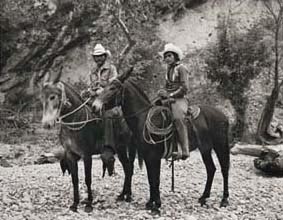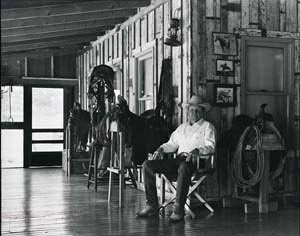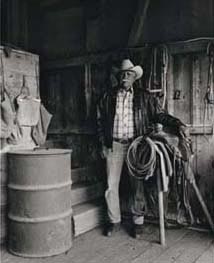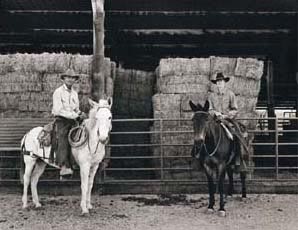|
|
|
|
|
|
|
|
|
|
|
|
|
|
|
|
|
|
|
|
|
|
|
 |
|
|
|
|
|
|
|
|
|
A father and son from a ranch somewhere in the neighborhood–I can’t
even remember their names or their faces–had helped us gather
cattle one fall day in 1963. The bunch was traveling well, and
the son (let’s call him Mike) and I were in the “drags.” Mike,
who was a year or two my junior, took down his rope and threw
out a nice stand-up loop that trapped the hind feet of a rear
echelon cow. The boss didn’t object to this practice shot, so
Mike connected with another, then gave me a look that was clearly
an invitation for me to follow suit. But my rope stayed in its
usual place, as saddle decoration.
Mike shrugged and said, “Here, check this out.” He shook out a
considerably bigger loop, and from a single ass-backwards-looking
swing launched it out over the hindquarters of another cow. The
loop hung there, and as she walked it kept drooping down under
one side until she stepped into it. Mike jerked his slack and
had her by both heels. “That’s a good one to know,” he allowed.
I realized, then and there, that I wouldn’t need to learn that
loop, because soon I would head to the city to engage in the profession
I had trained for–architecture. I also felt, with absolute certainty,
that Mike, who had perfected his loop, would become, as the cowboys
say, a “lifer,” and that his way of life would last forever.
Back then I was 26, single, and unwinding from a stint in the
peacetime Army. Rancher Warner Glenn was 27 and my boss. To this
day I am still amazed that Warner and Wendy took this wide-eyed
pilgrim into their world, and even paid me the going wetback wage
for my blunderings.
Turns out that, thanks to my unexpected but fortuitous transition
from architecture to photography, I have avoided the grip of cities
and have often prowled the landscape of the West with saddle and
camera. The generosity and hospitality of the Glenn family was
but a preview of the wonderful reception that I have consistently
received from the ranching community. As I revisit nearly 30 years
of photographing on the cattle ranges of the West, I am grateful
for what has persisted and am alarmed at what has disappeared.
|
|
|
|
|
|
|
 |
Gilberto Rivera and Francesco Carranza, Rancho El Diablo, Sonora,
1985
A book project that writer Alan Weisman and I were working on
brought us to a beautiful canyon in the borderland country just
west of the Continental Divide, which is the boundary between
the Mexican states of Sonora and Chihuahua.
While photographing on a certain ranch, we saw these vaqueros
ride up, and were told that they were from a neighboring ranch.
The bronc mare mule, on the left in the photo, was snubbed up
to the saddlehorn of the gentle mule, and progress was, at times,
erratic. I asked Alan, who is fluent in Spanish, to ask the men
if I could photograph them, and was disappointed when they politely
turned down my request.
Later in the day and farther down the canyon, the duo reappeared.
La Bronca was free of her tether and moving along nicely. Now
the vaqueros were willing to be photographed, and I had one sheet
of film left.
|
|
|
|
Three Generations: Bill, Skeeter and Mack Hughes, Diamond 2 Ranch,
Arizona, 1984
Back when this photograph was made all three of these gents were
running ranches. Skeeter managed the Diamond 2, his son Bill ran
the neighboring Cross S, and his father, Mack, worked a small
family outfit several hundred miles away. For many years Mack
was the stockman in charge of one of the ranch divisions of the
vast San Carlos Apache Reservation. Mack, who started cowboying
around age 12, was still plying his craft well into his eighties,
some time after Skeeter and Bill reluctantly turned to “real”
jobs. Mack is gone now, but will be long remembered as the subject
of the classic “Hashknife Cowboy,” authored by his widow, Stella
Hughes.
|
 |
|
|
|
 |
Buster Welch, Welch Ranch, Texas, 1986
The celebrated cutting horse trainer Buster Welch grew up cowboying
throughout much of west Texas, which included riding the rough
string for the legendary Four Sixes. Of Welch’s early years on
the range, my friend Tom McGuane writes that, “Buster learned
to shape large herds of cattle and began the perfection of his
minimalist style of cutting horsemanship and ranching in general.”
The fact that Buster Welch is a cattle rancher of long-standing
tends to set him apart from the rest of the cutting horse world.
On a working outfit a colt can become a cowhorse before he is
asked to “deliver” in the cutting arena. Concerning Buster’s philosophy
and practice, McGuane continues, “In the age of proliferating
horse whisperers, his methods are direct, based on reaching an
under-standing with the horse that there is a job to be done.”
|
|
|
|
 |
Jesús Bracamontes Lucero, Vail & Vickers Ranch, Santa Rosa Island,
California, 1998
The Vail & Vickers Company, of Santa Barbara, owned and ranched
the 54,000-acre Santa Rosa Island, off the Southern California
coast, for nearly a century before the government deemed that
it become part of the Channel Islands National Park. I had the
bittersweet experience of riding with Jesús Bracamontes and the
ranch’s other vaqueros on the last cattle roundup in that “Garden
of Eden,” a grassland paradise reminiscent of coastal California
before the developers came.
Mounted on confidence-inspiring, island-raised horses, we gathered
cattle on windswept headlands and canyon slopes steep enough to
retune your pucker-string up an octave. The last boatload of fat
steers left Santa Rosa in the summer of 1998, 13 years ahead of
the agreed-upon schedule and under extreme pressure from several
quarters. The island’s remaining grazers, the herds of Kaibab
mule deer and Roosevelt elk that were successfully introduced
early in the 1900s, must be fully “deported” by the close of business
in the year 2011.
|
|
|
|
Warner Glenn and Kelly Glenn-Kimbro, Malpai Ranch, Arizona, 1996
The Glenn family has ranched in southeastern Arizona for generations,
daughter Kelly’s generation being the fifth. In addition to running
two ranches, the Glenns are hunting guides and outfitters, and
Warner is renowned for his half-century of experience with mountain
lions. On a March 1996, guided hunt, a hound on Kelly’s circle
jumped a hard-running cat that appeared, from its tracks, to be
a big tom lion. After an arduous rough-country chase, Warner,
riding the good gray mule he calls Snowy River, caught up with
the fleet quarry that had broken bay several times–a magnificent
male jaguar in his prime. After grabbing several chilling closeup
photographs, Warner managed to get his dogs out of harm’s way,
then marveled as the great cat trotted southward toward its Sierra
Madre homeland in Mexico.
The decades have brought numerous changes to much of the West,
yet relatively few to the place where the jaguar ran. The region
has been ranched steadily since the time of Geronimo, is sparsely
populated and has not been compromised by development. It’s the
home range of the Malpai Borderlands Group, which has received
international recognition for its work to protect open spaces,
wild lands and traditional livelihoods, thus perpetuating the
concept and reality of working wilderness.
|
 |
|
|
|
|
|
Editor’s note–more about the people and places depicted in this
portfolio can be found in the following books: “Hashknife Cowboy:
The Recollections of Mack Hughes,” by Stella Hughes, University
of Arizona Press. “Some Horses,” by Thomas McGuane, The Lyons
Press. "Eyes of Fire: Encounter with a Borderlands Jaguar,” by
Warner Glenn, Printing Corner Press (contact Malpai Ranch <www.jaguarbook.com>
or 520-558-2470. “Cowboy Island: Farewell to a Ranching Legacy,”
text by Gretel Ehrlich, edited by Nita Vail, Santa Cruz Island
Foundation.
Photographer Jay Dusard of Douglas, Ariz., received a 1981 Guggenheim
Fellowship that led to the publication of “The North American
Cowboy: A Portrait.” Between travels to photograph and teach workshops,
he raises a few quarter horses, punches cows and plays jazz cornet. |
|
|
|
|
|
|
|
Table of Contents | Git Home!
To Subscribe: Please click here for subscription or call 1-800-RANGE-4-U for a special web price
Copyright © 1998-2005 RANGE magazine
For problems or questions regarding this site, please contact
Dolphin Enterprises.
last page update:
04.03.05
|
|






